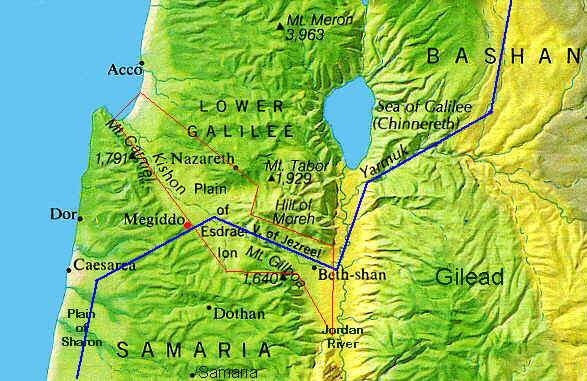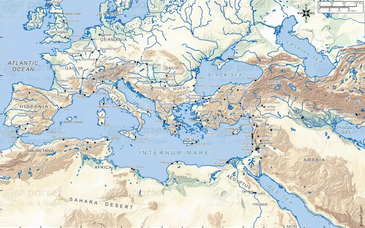
The Valley of Jezreel is often identified as comprising only the eastern end of the Plain of Esdraelon, the valley between between Mount Gilboa and the Hill of Moreh and Mount Tabor (see Mount Tabor). However, Jezreel is often used generally to refer to the entire flat and fertile plain stretching southeast from the coast north of Mount Carmel to the Jordan River at Beth-shan (outlined in red). This area is the boundary between Samaria to the south and Galilee to the north. Even today, as in ancient times, this area is the most fertile agricultural land in Palestine, which is reflected in the name Jezreel, which means "God sows."
In ancient times, this area had great strategic value as well, since the Jezreel/Esdraelon plain was the only east-west access between the coast and the Jordan Valley. The main north and south trade routes between Egypt to the South and Mesopotamia to the North lay through this area. With the desert to the east, the areas on both sides of the Jordan blocked by highlands, and difficult access to the Jordan Valley from the south because of the Dead Sea, most north-south travel led through the Valley of Jezreel. The main route from Egypt, know as the Via Maris ("way of the sea"), ran northward along the coastal plains to the spur of mountains running to the sea at Mount Carmel just north of Caesarea. It then turned eastward toward the Plain of Esdraelon past the fortress of Megiddo, through the Jezreel Valley to Beth-Shan, then northward through the Yarmuk River valley toward Damascus (route marked in blue). A more difficult secondary route ran north from Jerusalem through Shechem and Samaria to Megiddo, then eastward toward the coast at Acco, then northward along the coast to the Phoenician ports at Tyre and Sidon.
Not only traders used these routes. Palestine was located on a narrow strip of land between Egypt to the South and the great civilizations to the North. As a result, through history it became a corridor for invading armies bent on conquest, all of which had to funnel through Jezreel. Since this was also the most level land in the area, Jezreel/Esdraelon became a favorite site for battles. Although the area was controlled in the early biblical era by the Canaanites equipped with chariots, Gideon managed to defeat the Midianites and Amalikites here (Jud 6:33-7:23). The area was in Israelite hands by the time of Solomon, who fortified the ancient fortress of Megiddo to guard the pass (1 Kings 9:15). In was on the plains of Jezreel that Jehu's army defeated the armies of Jezebel (2 Kings 9), beginning a bloodbath in the Northern Kingdom that would have consequences for years (cf. Hos 1:4-5). And it was at Megiddo that King Josiah was killed in a fateful attempt to block Egyptian armies from using the pass to march north to lend aid to Assyrian armies trapped by the Babylonians (2 Kings 23:29).
There was so much bloodshed in these plains that both Jezreel and Megiddo became synonyms for violence and bloodshed, and could even become symbols for the judgment of God (Hos 1:4-5). The Mountain of Megiddo, in Hebrew har megiddo anglicized into Armageddon, became the ultimate symbol for warfare and conflict.
